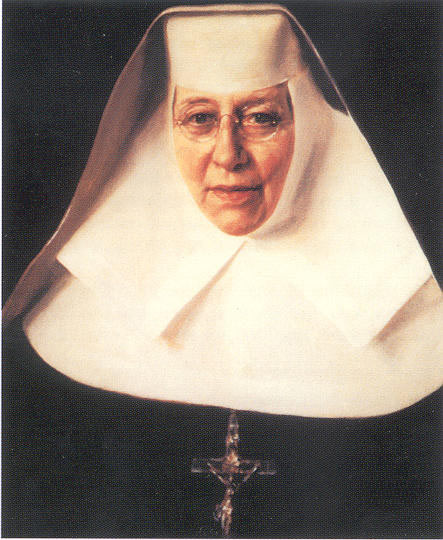Katharine Mary Drexel (26 November, 1858-3 March, 1955) was born in Philadelphia, Pennsylvania. She enjoyed a life of comfort and privilege before deciding to use her inherited wealth to establish a new religious order within the Roman Catholic Church.1 For her life and work, she has been formally recognized by her Church as one of its saints.2
Her parents were Francis Anthony Drexel and Hannah J. Langstroth Drexel. While Katharine was still in infancy, her mother died, and two years later her father married Emma M. Bouvier. Thus through her step-mother, Katharine Drexel was related to the future Jacqueline (Bouvier) Kennedy.
Katharine Drexel’s father and uncle were bankers. Francis Anthony Drexel and his brother, Anthony J. Drexel, were partners of Drexel, Morgan & Co., the Morgan being J. P. Morgan (1837-1913). The Drexel wealth was used to support public philanthropy and private charity. While Drexel University derived from their benefaction, so did twice-weekly feeding of any poor person who came to their door.
In 1885 Francis Drexel died, and he left his daughters a trust fund worth $14 million. Two years later, Katharine Drexel and her sisters made a pilgrimage to Rome. There, Pope Leo XIII (1810-1903) encouraged her to become a missionary to the American Indians, and so as a result of this life-changing encounter with the Pope, Katharine Drexel decided to found a religious order for women who would serve as missionaries to the Indians.
With approval of her bishop, in 1891 she founded the Sisters of the Blessed Sacrament for Indians and Colored People. As a nun, she was known as Mother Mary Katharine, though usually simply as Mother Katharine. From its base in Bensalem, Pennsylvania, the Order sent sisters to establish schools across the country, primarily in the West and Southwest. In 1925 Katharine Drexel founded Xavier University in New Orleans, Louisiana, the first Catholic university for African Americans.
In the 1890s Drexel gave financial help for the building of the new Saint Patrick’s church in Carlisle. Its pastor was Fr. Henry Ganss (1855-1912). Immediately to the east of the church building the rectory was built. Further to the west a school was constructed called Saint Katherine’s Hall, named for Saint Katherine of Alexandria, an early fourth-century Christian martyr. That school was intended for the Catholic Indians studying at the Carlisle Indian Industrial School. Drexel provided not only funds for Saint Katherine’s Hall, but also staffed it with her Sisters of the Blessed Sacrament.
In 1935 Drexel suffered a debilitating heart attack. She ceased her many travels, and for the next thirty years she worked at the Order’s motherhouse in Bensalem, Pennsylvania. There Katharine Drexel died on 3 March, 1955.
Thousands of people filed past her open casket, and after a requiem Mass celebrated at the cathedral in Philadelphia by the Archbishop of Philadelphia, she was entombed at the motherhouse of her Order. A Jesuit who had met her wrote at the time of “the light and joyous incisiveness of her own character” and of her commitment to the Catholic Church and her “really divine intuition which made her place contemplation at the heart of her Order’s activity.”3
In 1988 Pope John Paul II beatified her, and in 2000 he canonized her. Her feast day is March third. After her beatification, the first parish in the world named for her was founded in Hampden Township. Between the narthex and the pews is a stained glass window of Drexel.
In 2011 Robert Barron presented a profile of Drexel in “The Communion of Saints,” Episode 8 of his television series Catholicism. He used her story to exemplify the virtue of justice.4
Visit the Twentieth Century Hall of Fame

